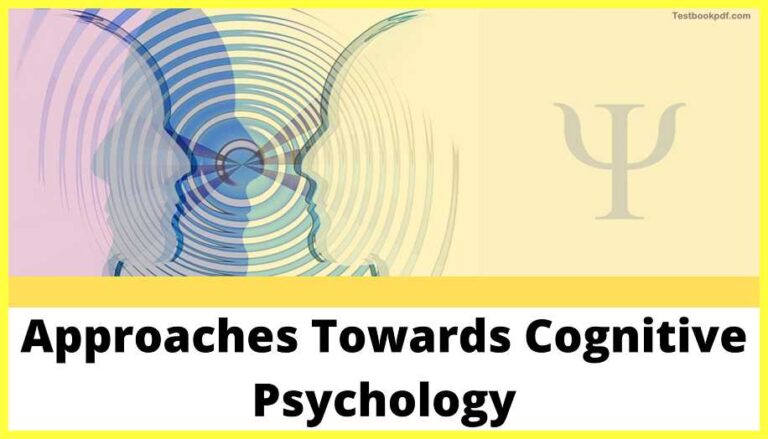Approaches Towards Cognitive Psychology
Today the title of the Article is Approaches towards cognitive psychology. In today’s article, we will basically talk about the various approaches that have been taken to understand the architecture of the mind and the mind Brain relationship.
To uncover the architecture of the black box (Human Mind) single approach may not be sufficient. This article covers the Cognitive Approach, AI Approach, Neuroscience Approach, and Information Processing Approach, These are some of the approaches used to understand the functional architecture of the mind.
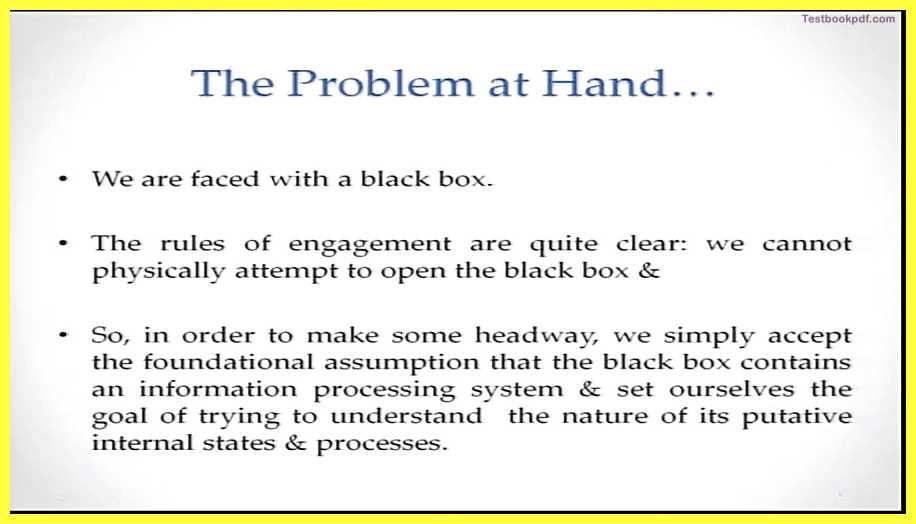
If you remember in the last few Article if we till now talked about the definition of cognitive psychology. We have talked about how cognitive psychology is the study of the human mind and of mental processes. We also talked about the fact that cognitive psychology basically seeks to understand and explore the functional architecture of the human mind. in the last most recent class if we talked about the fact that cognitive psychology basically also in some sense follows the metaphor that the mind is to the brain what is software is to computer hardware. So we will try in take forward this approach towards thinking about the mind, brain relationship and we will try and see what are the various approaches that have been taken to understanding this relationship, this analogy between the mind is the software and the brain being the hardware.
Mind-Brain
In this current Article basically, then we will look at this mind-brain or the software, hardware approach and we will try and also contrast some of the other approaches like the neuroscience approach or the artificial intelligence approach as such.
Now just to actually begin the problem or to begin talking about the problem. Let me refresh the problem for you to really understand what are we talking about. Now in the last classes, we would have seen that one of the aims of cognitive psychology is actually to understand how the brain is structured or how the mind is structured basically.
Another point is, that there is a bit of a problem for us as compared to somebody attempting to understand another machine. We are faced with something which is similar to a black box. We do not know or a priority what is going on in this box. We do not really also know what are different, let us say what sets of neurons in the brain are doing.
The black box
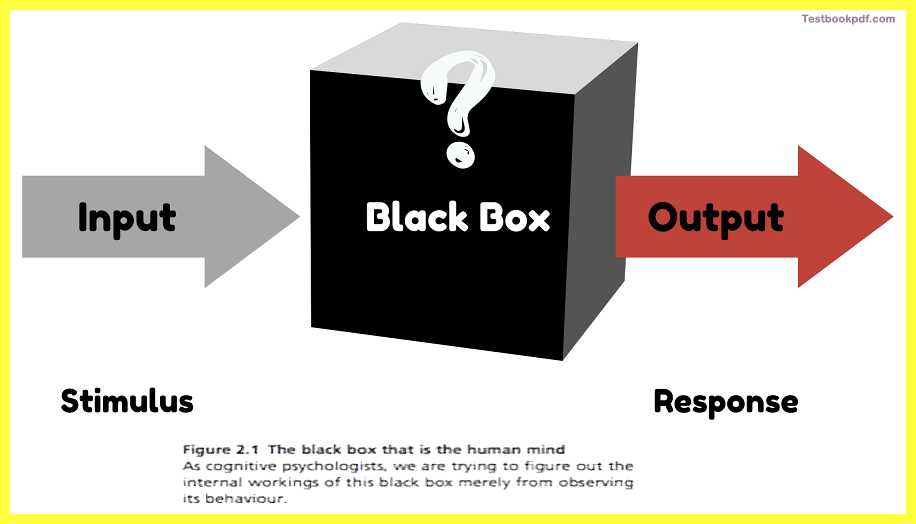
So, in that sense you can assume that we are actually dealing with the black box, we might know a set of inputs and we might note the set of outputs, but we do not have any other way to actually see what is going on inside the black box.
One of the things that are clear for researchers really approaching this problem at least in human contact is that we cannot really physically attempt to open this black box.
For example, if you dealing with any other machine and you want to understand how the machine works a typical mechanical engineer might really want to open this machine down to its bolts and tools, nuts and bolts. And actually, see how each of the parts is connected and what each of the parts is doing, but we do not have that luxury when you are talking about the human brain. So we will see what could be the alternative approaches to really see what is going inside the brain. That is exactly what another focus of cognitive psychology is.
So basically in order to make this head away, make or begin this inquiry what we do is, we simply accept a couple of things. So we accept this foundational assumption that the black box contains an information processing system. You give it some input, it will give you some output, whatever it is doing in the middle is information processing of some kind.
And what we try and do then is to understand the nature of the internal station processes, how information is processed when we are talking in a reference of the brain or in reference of this mind which is the abstract part.
Book by Quinlan and Dyson
So here you can see it is being very well visualized in this book by Quinlan and Dyson which the Article is basically based. We are actually talking about a set of input, and we are talking about a set of output, but at the center, the basic computational tool is your black box and we do not know much about it. We are trying as cognitive psychologists to understand and figure out the internal working of this black box.
From where do we begin when we have to understand this black box?
So how do we understand what this computer is doing so if we may call it a computer?
The aim or one of the things that could be done is that we get somebody and naive observer let us say to uncover what is going on when the computer runs a program okay. because I am talking about the computer and hardware and software analogy, let me give you an example in terms of a program.
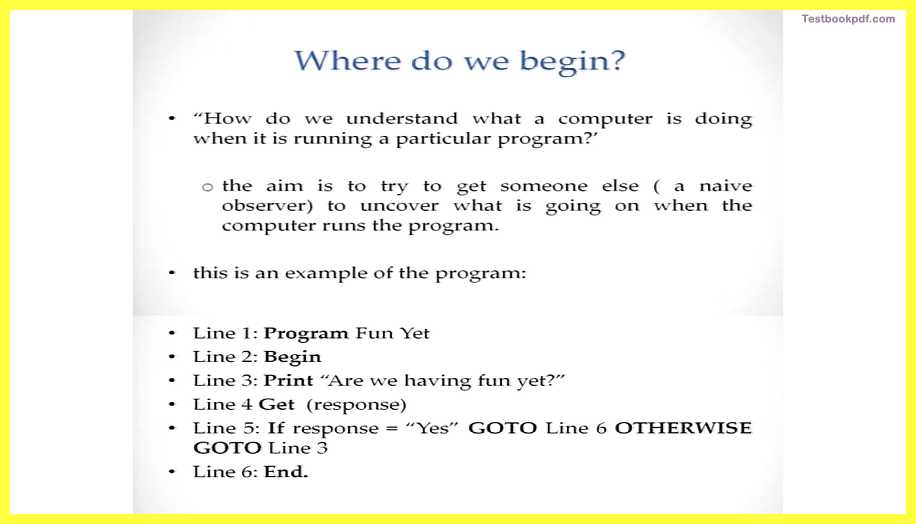
Now here is a simple computer program in any language. And the idea is that the program has these different line numbers, there is a particular input and there is a particular output. So the new of the program is fun yet you begin on the second line then you kind of type something or we have in fun yet and then some responses are given. The response is yes then you actually end the program and the response is no, you again ask the same question, this is a very simple program. Now if somebody really wants to understand how this answer is arrived at, he may take a variety of approaches to understand this.
The Cognitive Approach
Let us take this example to cognitive psychology update and try and see what cognitive psychology really does to approach such a problem.
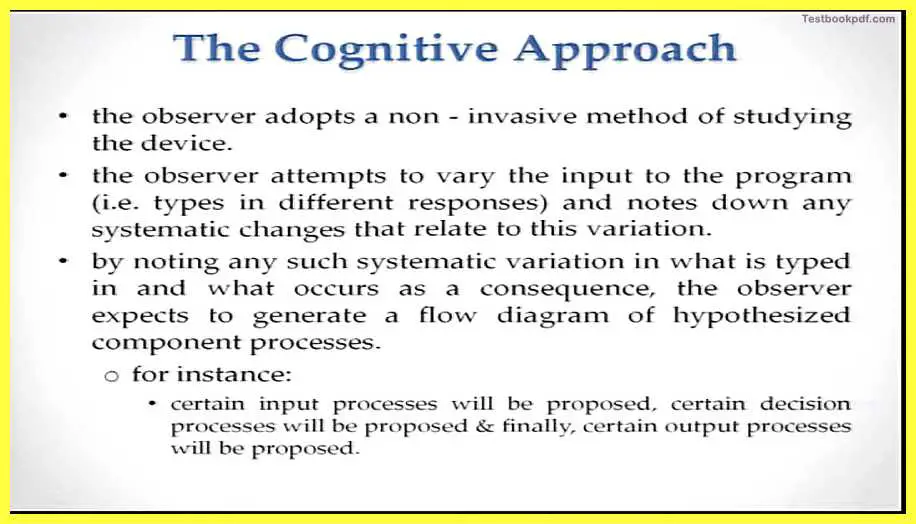
The first approach let us say could be the cognitive approach that we talking about. Here is what happens is that the observer has to compulsorily adopt something of a non-invasive approach. So what the observer does he can basically vary the input to the program he can type sometimes yes, he can type sometimes no, and then he actually would note down any systematic changes that had happened in the output.
For example, if you type yes you see what is done by the program we should type no you again see what is done by the program. And in that sense, you can make out that if I say yes the program exists if I say no that the program actually stays and ask the question again. This exercise in some sense will give you some idea about what these internal processes or what the internal decision-making system of the program is actually doing.
Now what happens is, in this sense when you actually undertake this exercise as an observer what you could do is. You can actually generate that these kinds of inputs will be given and certain decision processes say for example will be undertaken and a particular kind of output will be there. So this is the crux of the cognitive approach. This is something very similar to what do when we are trying to study the mental states or mental processes of the brain. You try and see what you really use as a stimulus and how the brain responds to it and then we try and guess what kind of processing the brain would have done or said.
For example, what kind of mental function would have operative done this input to come up with such output.
The Artificial Intelligence Approach
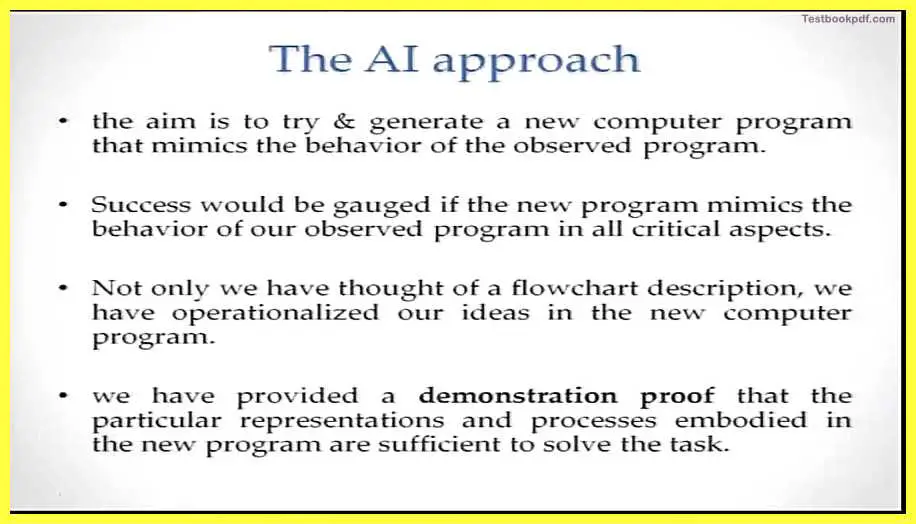
In the artificial intelligence approach, the focus is slightly different. You do not merely need to understand, you do not merely want to understand what is happening in this program. You want to actually go one step ahead. And how do you do that? You do that by actually generating a new computer program that mimics the behavior of the observed program. So what you doing is you are actually understanding or you are not really satisfied with just understanding what a particular program and question are doing. what you want to actually do is, want to create a parallel program, a new program that does exactly the same as this particular program has done. And in that sense, you will use that you have completely understood the process that this program would have taken.
Now the success or the failure of your new program basically would be gauged if the new program completely mimics the behavior of the observed program in all critical aspects. In the kind of outputs generated, the amount of time that is taken and taken and different parameters that you can think of.
Not only you should think of a flowchart description, you could also operationalize the ideas in the new computer programs. So you might have some guess that okay. I think that this program and question is using a particular kind of decision box. And you actually have a chance of implementing the same decision box which you think is being used by this earlier program. Anyway, implement that in your own program when you see is the output exactly matches that of the program in question. If it matches you might assume that okay maybe I have guessed correctly that this was the decision box. This was the decision process that the program in question was following.
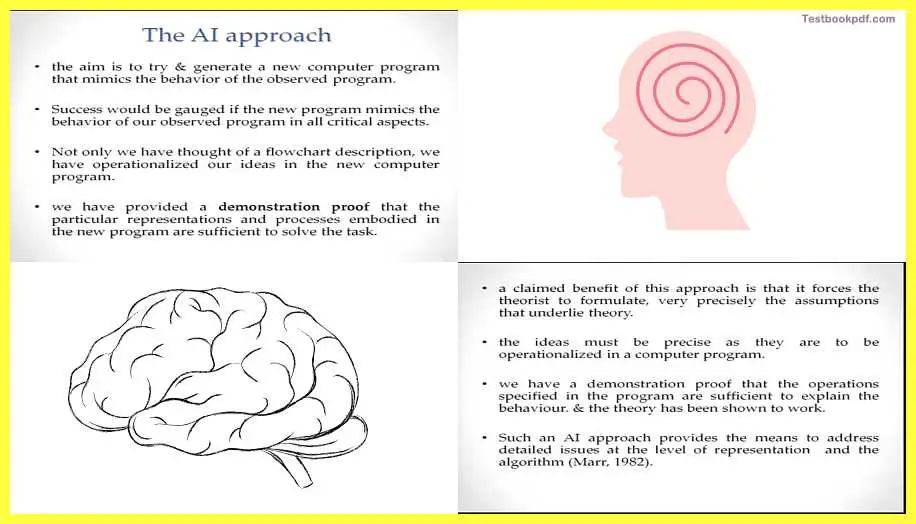
Now, this kind of approach gives you the satisfaction of having demonstration proof. Once you actually check out all of your assumptions in this new program what you have made what you have is demonstration proof. The demonstration proof basically tells you that whatever particular representation and processes that you would think of about this program in question are actually being followed. Because you created the program of yourself that really mimics and that really does the same thing. It is pretty much similar if you think of what we are trying to do with robotics. You are trying to build and create robots that would actually process the stimuli and the information in the real world as humans are doing.
For example, we are trying to build robots that actually talk to humans like, humans would do which process the visual stimulation say for example depth and color and shape just like humans would do. You are also if you would know of that we are also thinking you are self-driving cars, cars driven by this artificial intelligence method which basically follows the same kind of methods that the humans would do or maybe even better. This is pretty much what is the artificial intelligence approach to understanding the mind, and brain relationship.
What are the benefits are such an approach?
The claimed benefit of such an approach most importantly is that it would force a theorist to somebody who is trying to understand to formulate very very precisely the assumptions that underlie the theory of the other program that you would want to study. So unless you have actually given a very very precise statement that I think this is exactly happening, this is the next step, this is the third step, and the fourth step. You will not be able to implement that in your program. So it kind of limits the scope of letting us say in some sense speculative theorization. You have to come up with very very sharp and clear assumptions and those assumptions are those virtual anyways test it out in your own program. So that is a very important benefit of the AI approach.
Demonstration Proof
Another thing is as I said earlier that you have demonstration proof. That tells you that the operations that you specified about the earlier programs are sufficient to explain the behavior of that program. Because you could anyway is testing it out in your own program. The same kind of output you generate. So in that sense, you can actually see that, this is done. Now, something of note here will be that you should keep in mind that it is very possible for two rather different programs to actually take some input and generate identical outputs. That is something which we would need to keep in mind while you are actually following the AI approach, and I am sure that to some extent that is also being in the discipline.
So, this is one of the things also if you remember in the last article we will talk about Marr’s, levels of explanation, the algorithmic level, the computation level, and those kinds of levels the AI approach forces you to generate very explanations on those levels as well. So that is again to the merit of the AI approach to understanding the mind, and brain relationship.
The Neuroscience Approach
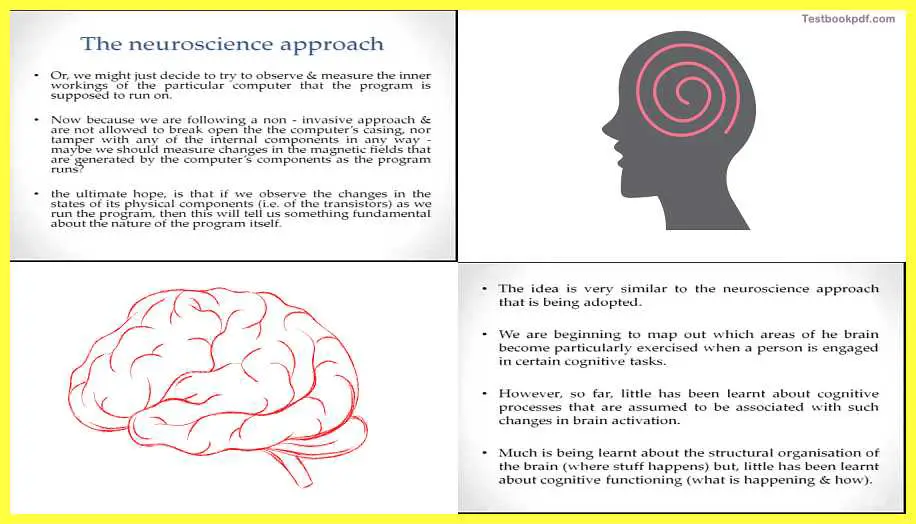
The neuroscience approach is actually something similar to what the hardware approach would be. You actually want to understand the machine you really want to understand how the different parts of the machine are connected. What is the role or the functional role for each of the parts of the machine? So neuroscience approaches pretty much the same approach applies to the human brain.
The point is – how do we proceed with the neuroscience approach given the fact that we have to be non-invasive and we do not have the luxury of opening this machine, So one of the ways could be to just try to measure the inner states or inner working of this computer or this brain we are talking about. Because you are following a non-invasive approach and we are not allowed to break open the computer’s casing and different parts what we can do is, basically try to have some indirect measures. So, we may try and measure the let us say the magnetic field around the parts of the components.
For example, if a particular process is being done, what is the nature of the magnetic field of the different parts things like that. Very similar to what the current neuroscience approach is actually doing.
The ultimate hope with this neuroscience approach is actually that if we observe the changes in the states of its physical components the component of this machine as we run the program then they should tell us something very fundamental about the nature of the program itself.
for example – if you give a particular kind of output, and you see how the machine is changing, how the internal states or some indices of these internal states are changing. You would know that this is what is happening in response to this input and that is how a particular kind of output is being generated.
FMRI
So I will take examples one of the very papular methods in neuroscience is this approach of FMRI wherein what we actually do is measure the blood flow in various areas of the brain. In response to particular kinds of stimulus
For example – if I have actually shown your face there is a particular area in the brain where the blood flow will maximize in a relation to other areas. And that is how we did use, that this is the area which is implicated in the processing of these kinds of stimulus which is the face. Again it is something similar to trying to understand what the brain does. When you present to it a face and what kind of output it really produces so what is the output to the face probably the fact that you recognize that it is a face, second you will recognize the person to whom the face belongs and similar other things.
Now, this idea is actually as I said rather similar to what is currently being done. Now, the current state of the hard disk is like we are already now being to map out which areas of the brain are particularly exercised when a person is engaged in a certain cognitive task.
For example – tasks like reading, tasks like understanding or recognizing a face, and those kinds of things. However, I might observe that so far rather little has been learned about the cognitive processes that are presumed to be associated with such changes in brain activation. Let us say we have knowledge about that these, these areas are involved in these particular cognitive functions, but if you ask neuroscientists to really make a very strong claim I think we are still not there. Obviously, you can say that this area is responsible for letting us say face recognition or word reading or say for example attention and stuff like that, but the point is, we are not really 100%, I mean at the place that we can explain one by one what are steps what as basically happening with respect to these different brain areas. Already though to the credit of the field much is still being learned about the structural organization of the brain where each of these different kinds of stimuli is being processed but still, we have a long way to go really to understand how each of these areas is implicated exactly.
Now, these different approaches as a part I will now take you toward rather a different kind of approach and we will slightly be moving away from the example of this program and the mind, brain relationship that we were talking about. Let us talk about cognition slightly in a more general sense.
Cognition Approach
Now if you actually trying to understand that cognition pretty much is basically or is very similar to somebody processing some information and coming up with the particular output. So there was the very influential approach which came out in the 1940s, end of the 1940s that really try to specify how information processing happens, and in that sense, it also kind of created a particular kind of theoretical framework for understanding how the human brain also process the information.
Now this information basically the information theory approach which is actually introduced by Shannon and Weaver in 1949, and it was supposed to be a mathematical account of the operation of any type of communication system. Any communication system can actually be approached theoretically through this particular approach.
What is this approach do?
This approach basically provides the basic assumption that underpins our ideas about what information processing systems are. How information processing is actually done. What are the various parameters?
Information Processing Approach
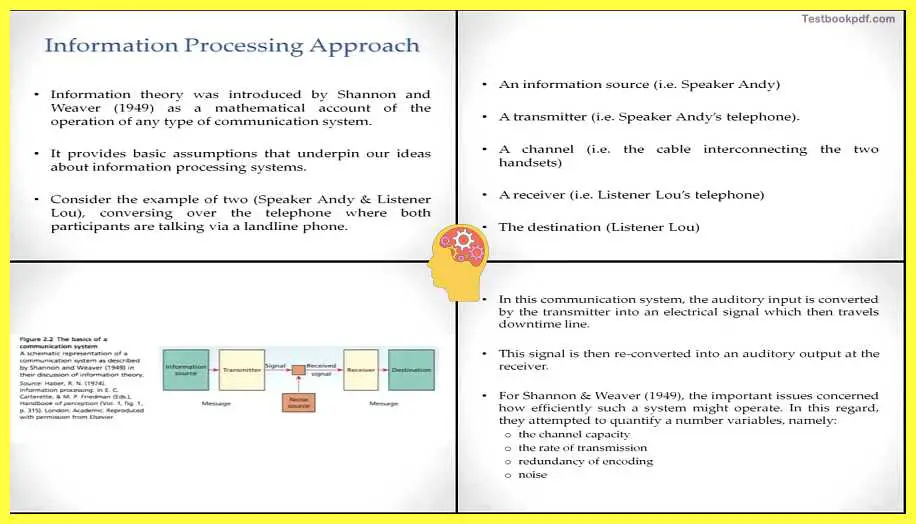
So, let us say it takes the example of two speakers that may be connected by a wireless phone or wired phone or something like that. We are talking about this telephone and some kind of messages being interchanged. It is A component of such a typical setting. So you have an information source that is a speaker one of he could be Andy or anyone. And then you have a transmitter, so the information source actually transferred some kind of message through this transmitter which is the transmitter in this case let us stay Andy’s telephone over which Andy is speaking who is the information source. Then you have to have a channel through which this information will be passed, so let us the cabal connecting the two handsets or let us say a satellite connecting the wireless connecting these two phones wirelessly. And then you have the receiver which is Lou’s phone who is the person Andy is talking to, that will be the receiver. Another aspect is the destination which is Lou himself who is actually receiving this message which is basically sent via the speaker who is Andy. So typically an information arising system or other simple idea is that –
- You have an information source.
- Transmitter.
- Channel.
- Receiver.
- Destination.
These are the five components of any rather simplistic information system. Here you can actually see the visualization of this information processing system. So you have an information source, you have a transmitter, you have a place where there is a source been transferred and in a receiver and a destination. So this is typically the setup.
Now what happens is, in this communication system the auditory input actually first needs to be converted by the transmitter into an electrical signal which will actually travel through the channel okay this is one of the steps. Another is that the same signal which has been converted the same in an electric signal which was basically earlier information sources has to be reconverted into the information source that kind of information that was being sent already at the point where the receiver is, at the point whether receiver basically gets this information from the channel.
So what Shannon and Weaver did is they actually considered these important issues and they said they could be a few variables that might be necessary to take into account when we are talking about such a system of the variables as channel capacity.
Transmission
How much information can this channel actually carry The second is the rate of transmission and how fast, nowadays we are talking about high-speed internet. So what is the rate of transmission? The third is the redundancy of encoding. How much meaningful information can actually be transmitted? I will talk about these things in more detail as we go ahead. And the fourth is the noise, how much meaningful information versus how much noise or how much non-meaningful information you actually transferred through the channel. So these are the four factors. And these four factors or a ratio, those these four factors should decide how efficient your communication system is.
If you be with me and if you try and think this over you will kind of get the idea of what we are trying to do here trying to do, we trying to actually create an analogy of the way the brain might be processing, this wide variety of information that it is getting from the environment. But I will come to that in a while.
Shannon and Weaver
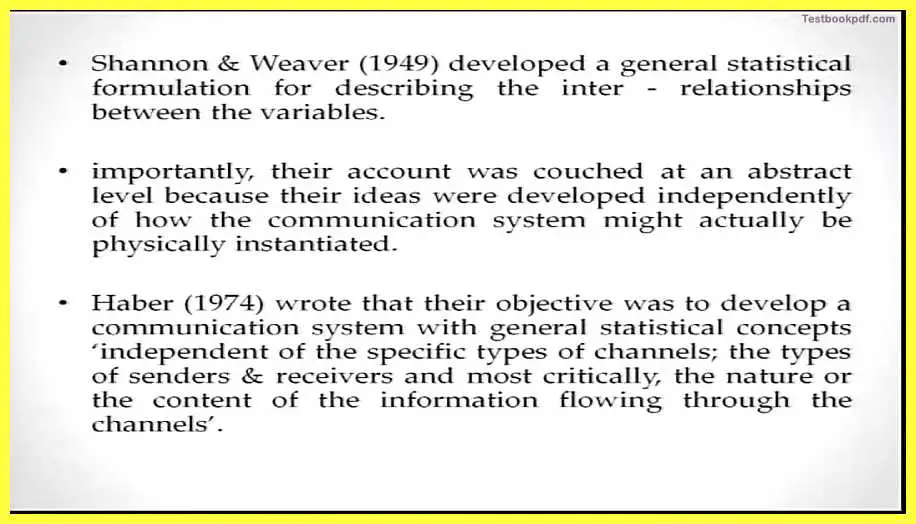
Now Shannon and Weaver were basically trying to develop a general statistical formulation for describing the interrelationship between these four variables we talked about importantly what they did was that their account was actually couching or at another abstract formulation, this was these entire variables and how information processing system is designed having all these four, five factors we talked about earlier is other attend abstract level. It is independent of what kind of transmitter or what kind of receiver you are actually considering or what kind of information is being transported through this particular channel. We are not really talking about those specific details as if now just talking about a typical communication system and what are the components of this communication system.
Haber
Now Haber 1974 basically writes that the idea that Shannon and Weaver had, was basically that they wanted to develop a communication system with the general statistical concepts. Independent of the specific types of channels, the type of senders and types of receivers, and most critically the nature of the container of information that is pretty much what they wanted to really do.
Information Theory and Redundancy
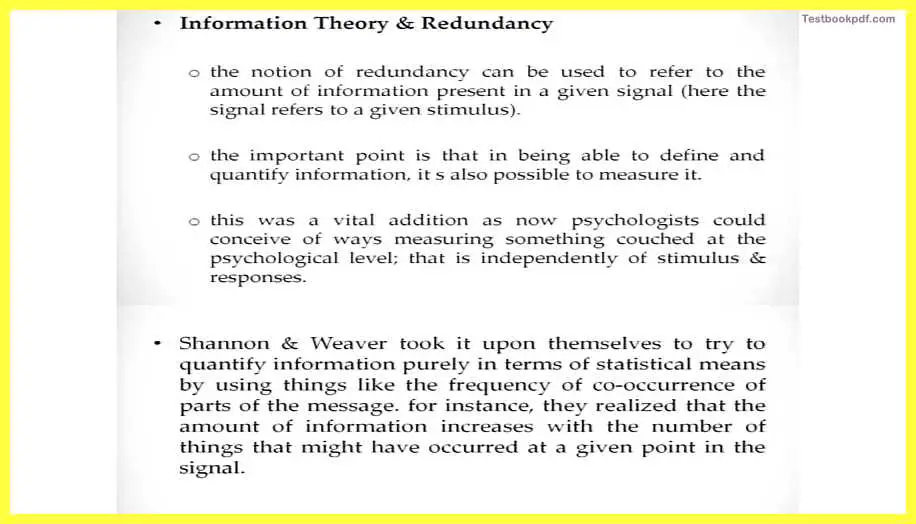
Now let me come to rather an important aspect of the information theory which is redundancy. it can be used to refer to the amount of information present in a given segment.
For example – I would say X is my brother and X is also the son of my father. So what I am trying to say here is that if I write these two sentences in a message I am actually one of these two sentences will actually be redundant, because say for example if I am already saying that x is my brother it should imply that is the son of my father or if I actually just say that x is the son of my father it automatically implies that x is my brother. So the whole point is that the entire message actually contains less information as compared to the length of this entire message. So one of the ways of computing redundancy is basically from a mathematical formula that it done the amount of redundancy is sees redundancy in a particular message log2 of the amount of information as compared to the total length of the message. That is one mathematical formulation we do not really want to talk about that in detail for our purpose, but just to explain, you have just given the idea of what redundancy should mean.
The important point in redundancy invites as valuable to us, that it kind of helps you to define and countrified amount of information present in a particular message. It also in some sense, gives you a way of measuring it. Now, this was a rather vital addition to the field of cognitive psychology in the sense that it allowed cognitive psychologists to conceive waves of measuring something couch at a psychological or abstract level.
If you remember the classes that have happened till now we have talked about the fact that, we are actually cognitive psychology the entire conception of what the mind is, or what the mental states are. They are couched in an abstract world. In an abstract reality. So this is something which you would need to keep in mind.
Way of thinking about Redundancy
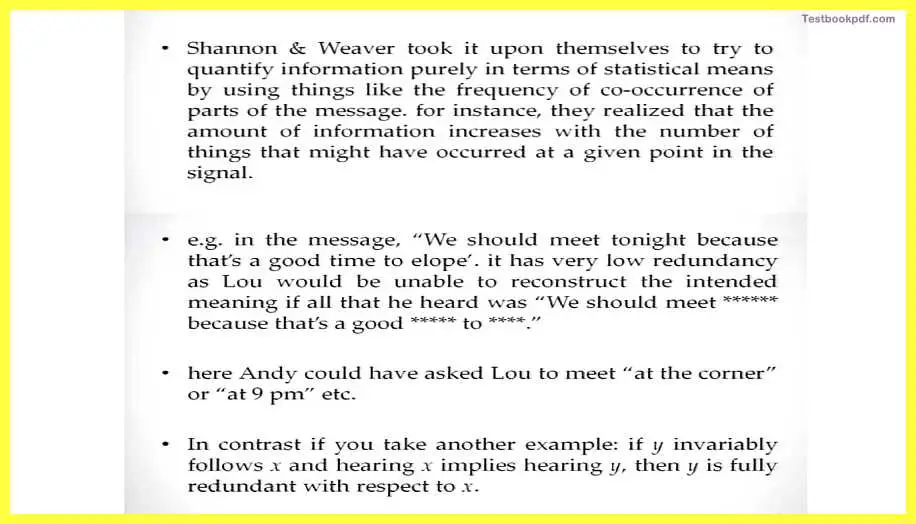
Another way of thinking about redundancy is in terms of how much the signal can be correctly predicted by other parts of the signal. So if you give the particular information whether that information can be already predicted from what is already known.
For example – if let us say the message is highly predictive what is basically one could actually get away in that sense by deleting the irrelevant bits and just leaving the relevant part. Say for example, if there is a various X and it is always followed by variable Y we do not need to specify separately for the variable Y, you would know that okay if X is there Y will anyways be there. That is how basically people could actually quantify information and find ways of measuring it.
Now Shannon and Weaver basically took it upon themselves to try to quantify information purely in terms of statistical means by using things like frequency of co-occurrence of parts of the message. For instance, they realized with the number of information increases with the number of things that might have occurred at a given point in the signal. So if we are just idea of the temporal unfolding of the signal, those kinds of things.
For example – there is a message that we should meet tonight because that is the good time to elope, which has a very low redundancy as Lou would be unable to reconstruct the intended message. Say for example what he heard was we should meet because that is a good dash to dash. Here and he could fill in different kinds of things, so the whole point is it is not easy to predict what the message was, so the message in that sense has low redundancy.
What is information processing theory give us about human information processing?
We know now that just modern world really depends on the variety of telecommunication systems that are fundamentally based on the properties and principles which were identified by Shannon and Weaver. So these early ideas also influence cognitive psychologies
For example by providing them a framework of thinking about how the human mind might be operating, how the human mind might be taking, and let our information about color and shape and different things and processing it. So in that sense, it actually provided a rather new theoretical framework.
It also provided the foundation for the assumption that the mind may be characterized as an information processing system whereby stimulation at the senses enters the complex communication system and then if kind of gets to a particular point.
Models of Cognitive Processing
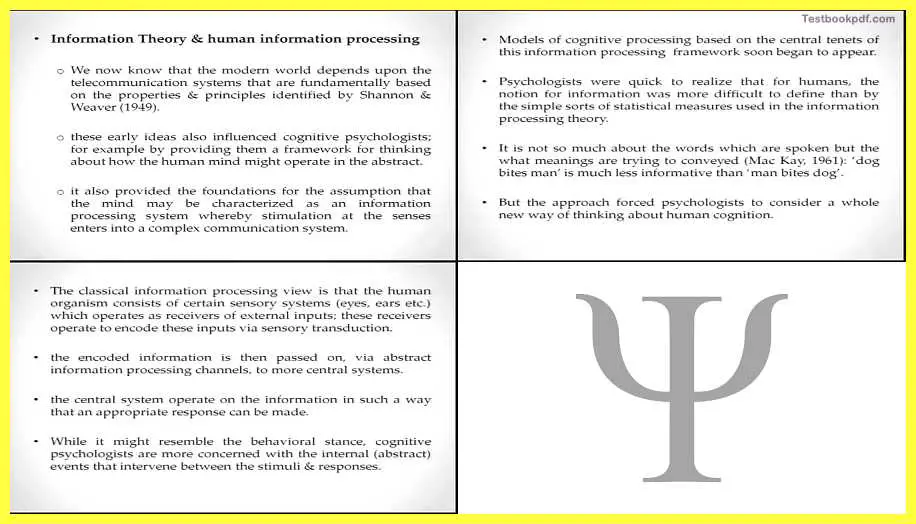
Now these different models of cognitive processing then which would be founded at that point in time were based on the central tenets of this information processing framework Shannon and Weaver had given.
For example – one of the earliest models of memory can send different models and those kinds of models. Now psychologists at that point then is very quick to realize that for humans, the notion of information would be slightly more difficult as compared to the notion of information for machines.
For example – dog bites man or man bites dog basically is the same set of information, but dog bites man actually makes much less sense than man bites a dog or the other way actually. But this entire thing actually forced the psychologists to really consider a whole new way of thinking about human cognition. It helps people come up with theories about how memory would work or how sensory processing would work and those kinds of things.
So this classical information processing view is basically that the human organism really contains these many sensory is that so many eyes, ears, nose, and the skin operate as receivers of external input, these receivers operate to encode these inputs via sensory transduction. So encoded information is then passed on, via abstract information processing systems to more central systems like the cerebral cortex or in the brain.
These central systems are there in the core of the brain, or basically trying to operate information in such a way that an appropriate sense of that information could be made.
For example, if you are seeing a bunch of shapes or a bunch of colors what the processing system will try to do is operate upon that mean search a way that you actually see shapes in there or you actually see that these are the objects in this amount of colors in lines and shapes. Now, this might resemble slightly the behavioral stance the cognitive psychologists towards basically more concern with the fact that how these internal abstract events are happening and what is happening between the stimuli and the responses.
At the end
So to sum up today’s Article what we talked about today were these various approaches towards understanding the mind, brain relationship, or what goes on in the mind and we also talked about a very important approach which is the information processing approach. Thank you.
Read also:
Foundations of Cognitive Psychology Theory
Foundations of Cognitive Psychology Part-2
Click here for Complete Psychology Teaching Study Material in Hindi – Lets Learn Squad
